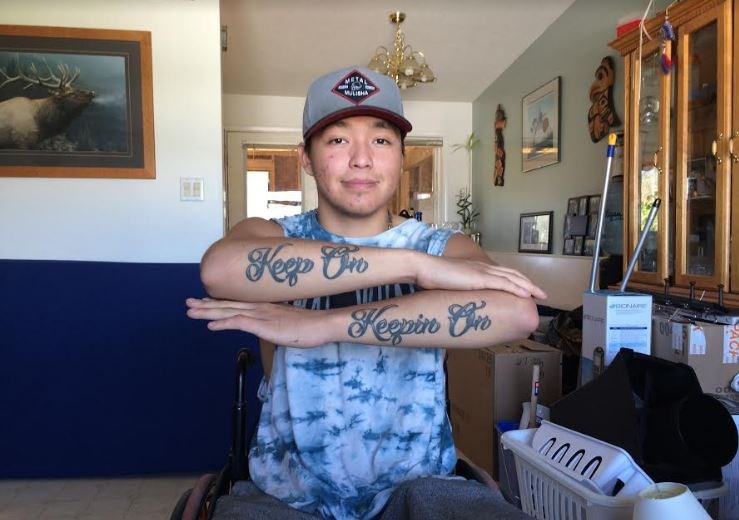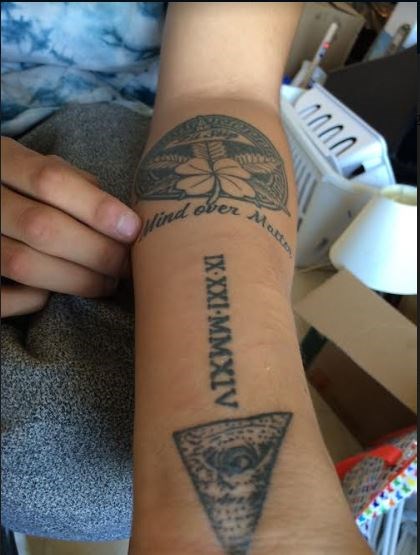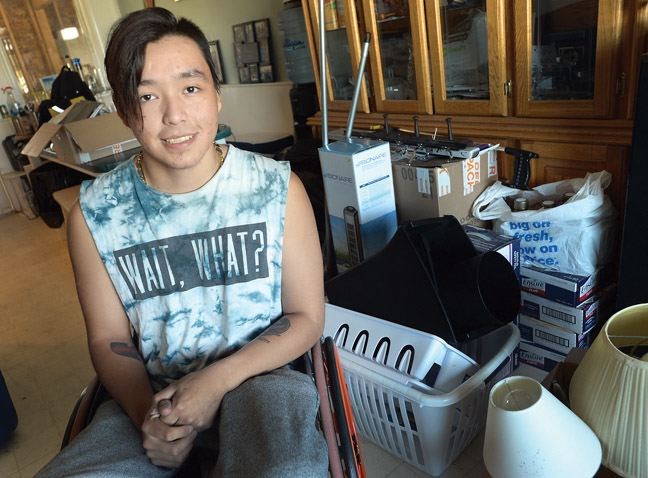Soon after Trent Seymour was paralyzed he started seeing his city in a new light. Steps blocked his way, uneven sidewalks slowed his path, parking spaces became hard to find. Prince George seemed unable to accommodate the wheelchair, now an extension of himself.
"I call it stair city," said Seymour.
Many communities suffer from poor planning, making it difficult and even impossible for people with disabilities to move freely. So Seymour was ecstatic when his hero offered him training and a job to try and change how companies, communities and government understand inclusive design and space.
"I'm 18 and I'm moving to the big city to work for Rick Hansen and he's like a god when it comes to the wheelchair community," said Seymour. "I'm still speechless."
This week his family packed a moving van and he loaded his grey GMC Canyon and drove the 10-hour trip to Vancouver. It'll be the longest Seymour has been away from home, other than the months-long stay at Vancouver General Hospital recovering from a horrific hunting accident. Almost two years ago, near his home on Shelley reserve a friend tripped with a loaded rifle, firing a .22-calibre bullet into Seymour's back, severing his spinal cord.
At the end of October Seymour will join about 200 people selected by the Rick Hansen Foundation as its pilot group of trained accessibility consultants.
"One of the big problems is nationally and globally there's no continuity, no established standards for training or qualifications to advise on accessibility," said Hansen.
So Hansen's foundation, under the banner Access4All, created a curriculum for people like Trent, who will act as advisors. Like the Leed certification model, Hansen envisions accessibility classifications - bronze, silver, gold, platinum - for assessed buildings and hopes his team of newly-trained advisors can offer recommendations to help organizations move to the next level.
"Trent will be one of the front line first pilot group," said Hansen, adding in the first phase - after six weeks of training - the accessibility consultants will be offered for free to organizations looking to improve accessibility. Timed for Canada's 150 birthday, the pilot will start in B.C. and Ontario and "scale exponentially" from there.
"I'm super excited about this because my original dream - the Man in Motion tour - was to create a world that is accessible and inclusive for all and back then the world was large and inaccessible and disconnected and today it's smaller, more connected and becoming more accessible."

Seymour speaks of the same dream.
"We want to make the world so open and free for people with disabilities," he said. "We won't be a forgotten percentage of the population."
According to the foundation, about 3.8 million - or one in seven Canadians - have a disability.
"It's trending rapidly upwardly in the next 20 years because we have aging baby boomers who are going to have many disabling conditions and of course their parents so we really need to think differently on how we dress the fundamental barriers," said Hansen by phone from Rivers Inlet, B.C. where he helped open an accessible salmon hatchery.
"It's no longer just a charitable issue and it's no longer just a human rights issue, it's also becoming an economic issue."
Shortly after the accident, Hansen visited Seymour in the hospital and the two have since struck a strong friendship, forged out of their similar experiences.
"From the outside looking in you wouldn't expect a guy that's almost 60 years old to relate and be so close with an 18-year-old but it's because he's lived what I've been going through and me and him share such a common ground. Every hardship that I've been through, (he's) who I go to," said Seymour, saying their bond is "like brothers."
Both were 16 at the time of their accident, athletes and both sustained same degree of injury.
"I can relate to what he's gone through," Hansen said. "(He is )a Cariboo boy who was a young athlete with lots of hopes and dreams and they seem to have been shattered along with the injury but I've also known that such a trauma can also be not just a tragedy, but it can be a triumph and a new opportunity," Hansen added.
"I was blown away by his spirit, his attitude, his wisdom beyond his years."
The new Seymour carries "all the best parts of the old me," but with new maturity and drive. That spirit is evident in his unwavering gaze, measured language and reminders he's tattooed to his body.
Right forearm stacked on the other, his palm pressed to elbow, the crossed arms form a sentence - "Keep on Keepin' on" - the phrase he'd repeat from the hospital bed, half-dead.
"Even though I was comatose and on drugs there was that part of me that was thriving when it needed to thrive. The inner strength. I was in fear for my life but I was more in fear for my family," he said, remembering how visitors' faces would change. "I could see them look at what I was. I was a 16-year-old kid that basically got gutted like a moose and had tubes everywhere keeping me alive."

Not all like Seymour lived, a reality that adds weight to Seymour's purpose. Zack Den Uyl, a fellow Kelly Road Secondary student and GF Strong Rehabilitation Centre patient, died at 18, less than two years after an accident left him quadriplegic.
Den Uyl loved music and would work on his mix tape as the two recovered.
"You could always do what you love, he taught me that," said Seymour, his finger pressed to his skin where Den Uyl's album cover art and its title, Mind over Matter, are memorialized. Below, in roman numerals, the day Seymour's life changed is inked in flesh too.
"If I look at this and realize what I went through on that day, it makes me really thankful for the most simplest of things."

Led Zeppelin, Pink Floyd and Iron Maiden posters already line the walls of Seymour's one-bedroom East Vancouver apartment. He's spent his first few days setting up internet, dealing with BC Hydro and unpacking boxes of clothes.
The last month he shrugged off the move, but the last week in Prince George Seymour found himself looking at the walls of his home and realizing he wouldn't be seeing it again for a long time. Daily life without family and access to his culture will be the biggest challenge.
Before his trip, Seymour visited local RCMP officer Jason Gillis' new sweat lodge, where he and others prayed for his future.
"It really cleansed my soul and my spirit," Seymour said. "It allowed me to go peacefully into my new beginnings."
He plans on smudging, connecting with friends and reaching out to the local native friendship centre for support.
And then there's Hansen.

"There are some nerves, but searching deep down inside I know I'm going to be okay and that's the place I need to be for my future and to accomplish all the goals I've talked to Rick about," said Seymour, who starts the internship Tuesday, and is most excited for the independence it brings.
"And the fresh start."
Vancouver simply offers more options, for movement, health care, professional opportunities and sport. Although Seymour had to leave his custom-built, all-terrain wheelchair behind - hunting isn't exactly an option in the city - he's excited to try sledge hockey and other activities that weren't available in the north.
"Any kind of sport you could manage in a wheelchair you could look forward to me trying it," said Seymour, who made a splash this summer as Canada's first paraplegic fastball umpire.
Mostly Seymour wants to work to improve the quality of life for people who struggle like him. To get there, Hansen "needs a whole army of him."
Almost 30 years after Hansen wheeled more than 40,000 kilometres through 34 countries, he is no longer one man in motion.
"It's many in motion,"Hansen said.
"And young Trents make me feel the next generation of champions and leaders are ready, willing, trained and able to push on and do much more work than I could ever do in my brief life."
Correction: A previous version of this story said 4.4 million Canadians are living with disability, when updated foundation statistics have that number at 3.8 million. It has also been updated to reflect the end of Hansen's man in motion tour, almost 30 years ago.



